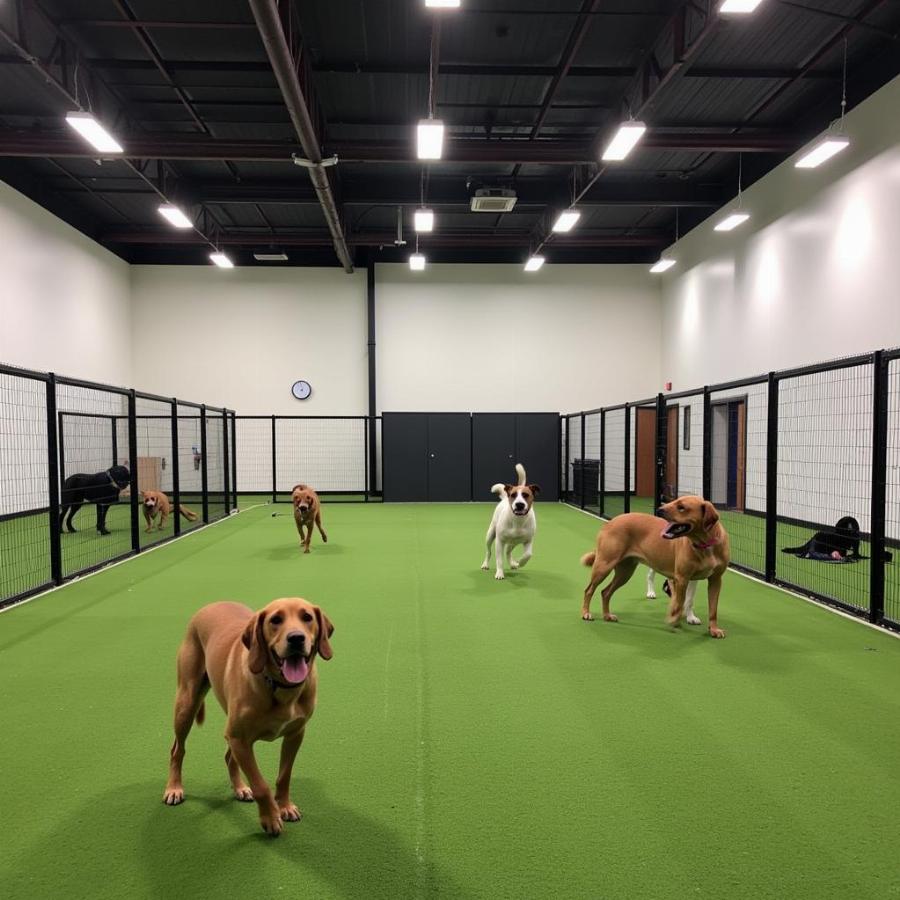Boarding dog training, often called board and train, provides an intensive training experience for your dog while they stay at a facility. It’s a popular option for busy owners who want to see fast results or address specific behavioral issues. This guide will cover everything you need to know about boarding dog training, from choosing the right program to preparing your dog for their stay.
What is Boarding Dog Training?
Boarding dog training involves sending your dog to live with a professional trainer for a period, typically ranging from a few weeks to several months. During this time, they receive structured training sessions throughout the day, focusing on obedience, socialization, and addressing any problem behaviors. The training is then transferred to the owner through follow-up sessions and guidance. This immersive environment allows dogs to focus solely on learning without the distractions of home life. It’s important to remember that board and train isn’t a quick fix; continued practice and reinforcement at home are crucial for long-term success. But, it can be a highly effective way to jumpstart your dog’s training and achieve significant progress in a shorter time frame. Think of it as a boot camp for your canine companion!
 Dog boarding training facility
Dog boarding training facility
Choosing the Right Boarding Dog Training Program
Selecting the right boarding dog training program is crucial for your dog’s well-being and training success. Look for facilities that emphasize positive reinforcement methods, focusing on rewarding desired behaviors rather than punishment. dog boarding & training offers various programs tailored to your needs. Visit the facility in person, meet the trainers, and observe their interactions with the dogs. Ask about their training philosophy, experience, and the specific program designed for your dog’s needs. A good program will also prioritize socialization, providing opportunities for dogs to interact appropriately with each other and humans.
Preparing Your Dog for Boarding Dog Training
Preparing your dog for their boarding dog training stay can ease the transition and make the experience more positive. Gradually acclimate your dog to being away from you for short periods, starting with a few hours and gradually increasing the time. Pack familiar items like their favorite toys, bedding, and a piece of your clothing to provide comfort and reduce anxiety. Ensure your dog is up-to-date on vaccinations and any necessary preventative medications. Communicate clearly with the trainer about your dog’s personality, medical history, and any specific training goals you have.
What to Expect After Boarding Dog Training
After completing the boarding dog training program, the real work begins! The trainer will guide you through the transition process and provide detailed instructions on maintaining and reinforcing the training at home. action pack dog center round rock is an example of a center that provides ongoing support. Expect follow-up sessions to practice the commands and address any challenges that may arise. Consistency and patience are key to ensuring your dog retains the training and continues to progress.
Is Boarding Dog Training Right for Your Dog?
Boarding dog training is a significant commitment, both financially and emotionally. It’s not a solution for every dog or every owner. Consider your dog’s temperament, age, and specific needs. If your dog suffers from severe separation anxiety or has significant aggression issues, a different approach might be more suitable. dog boarding oakland provides information on various training options. Consult with a veterinarian or professional dog trainer to discuss your dog’s individual circumstances and determine if boarding dog training is the right choice.
Conclusion
Boarding dog training can be a valuable investment in your dog’s behavior and your relationship with them. It provides intensive, focused training that can address a wide range of issues and accelerate learning. By carefully researching programs, preparing your dog, and committing to ongoing practice, you can maximize the benefits of boarding dog training and enjoy a well-behaved, happy companion.
FAQs
- How long does boarding dog training typically last? It varies, but programs generally run from a few weeks to several months.
- What types of behaviors can boarding dog training address? Obedience, socialization, aggression, anxiety, and specific problem behaviors.
- Is boarding dog training suitable for all dogs? Not necessarily. It’s essential to consider your dog’s individual needs and consult with a professional.
- What happens after the boarding dog training program ends? Trainers provide follow-up sessions and guidance to ensure the training is maintained at home.
- How much does boarding dog training cost? Costs vary depending on the program length, location, and the trainer’s experience.
- Can I visit my dog during the boarding training period? Policies vary between facilities. Some allow visits, while others discourage them to avoid disrupting the training process.
- What should I pack for my dog for boarding training? Familiar items like toys, bedding, food, and any necessary medications.
More questions? Other related articles on Beaut Dogs:
Beaut Dogs is your one-stop resource for all things dog-related, offering expert advice and reliable information on various breeds and their care. We provide in-depth guidance on health, nutrition, training, and grooming, ensuring your canine companion thrives. When you need personalized support, reach out to us via Email: [email protected] for detailed and accurate answers from Beaut Dogs.